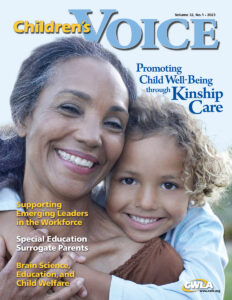Published in Children’s Voice, Volume 32, Number 1
by Susan Savage
Imagine receiving a call in the middle of the night asking you to take in your one-year-old grandson. You are single, 62 years old, make $38,000 annually, and must work tomorrow. What do you say? In the United States, our youngest children are the most vulnerable to maltreatment, with more than one quarter (28.1%) of victims under two years old (U.S. Department of Health and Human Services, 2019). Many children are removed from their homes, and kinship caregivers or relatives often are asked to take in these children—but these individuals tend to be older and earn low wages, which makes it challenging to care for a child (Scannapieco et al., 1997).
In Los Angeles County, some children stay at “Welcome Centers” or in the offices of children’s social workers while they await placements. If a child has special needs, is under age five, or is part of a sibling set (all needing placement), the number of calls required to secure a placement increases dramatically (CCRC, n.d.).
In 2017, the California State Legislature enacted a program, piloted in Los Angeles County, to remove this barrier and help alleviate the challenges that caregivers were experiencing. The program was taken to scale statewide in 2018 as the California Emergency Child Care Bridge Program for Foster Children (the “Bridge Program”), which breaks down silos and creates active collaboration between child welfare services (CWS) and early care and education (ECE) systems by providing child care vouchers, child care navigators (CCN), and trauma-informed care (TIC) training and coaching for ECE providers (see Figure 1). The Child Care Resource Center (CCRC) was funded by First 5 California, First 5 San Bernardino, and the Heising-Simons Foundation to evaluate the program in 12 California counties. CCRC surveyed and interviewed program leaders and staff, caregivers, and ECE providers to evaluate the implementation and effectiveness of the program.
Ensuring Family and Child Well-being
The 2018 Family First Prevention Services Act recognizes the importance of kinship placements, but these can be extremely difficult to secure. The Bridge Program increases the likelihood of placement, particularly with relatives, where 40% of resource caregivers said without the program they would not or were not sure they would have accepted the child(ren). This is particularly true for children 0-5 years old—who are the most vulnerable— because they are not yet in school. A caregiver from San Diego County shared, “It would have been hard. I would have had to turn down any child that wasn’t old enough to go to school.”
A key component of ensuring the safety of children placed in foster care is mitigating stress for resource caregivers. Developmental science shows that stress in the family can have adverse effects on children (Johnson et al., 2013). As one caregiver pointed out, “When a parent has stress, the child has stress. It goes hand-in-hand.” The Bridge Program has decreased economic and emotional stress of caregivers.
Early care and education is a complex system that is difficult to navigate. Often, parents ask, “How do I find ECE programs with openings for my child’s age group, are affordable, are conveniently located and can provide for the special needs of my child?” The CCN helps ensure a smooth transition, reducing stress for the caregiver and the child. As one caregiver noted, “I think it’s also great for the child to get some sort of structure and socialization. I think that’s really helpful, especially a child that’s maybe been in a traumatic situation. Making positive attachments and having some security and some regularity, I think that’s really important for them.” Caregivers reported in interviews that their children progressed socially, cognitively, and physically and built strong bonds with the child care provider.
This is an excerpt. To read the rest of this article, login as a CWLA member or download this issue of Children’s Voice here.
Dr. Susan Savage has over 30 years of research and evaluation experience and is currently the Director of Research at the Child Care Resource Center (CCRC), a large human-service organization in California. CCRC’s mission is to cultivate child, family, and community well-being. The agency’s research team is a highly diverse and skilled group of professionals who strive to ensure our work includes the communities we serve, ensuring our results have the greatest possible relevance and impact. The work is action-based and policy-relevant for both local and large-scale change.
References
Child Care Resource Center (CCRC). (n.d.). Research & evaluation services. Author. https://www.ccrcca.org/resources/research-evaluation/
Johnson, S.B., Riley,A.W., Granger, D.A. &, Riis, J. (2013). The science of early life toxic stress for pediatric practice and advocacy. Pediatrics, 131(2), 319-327.
Scannapieco, M., Hegar, R.L., & McAlpine, C. (1997). Kinship care and foster care: A comparison of characteristics and outcomes. Families in Society, 78(5), 480-488.
U.S. Department of Health and Human Services. (2019). Child maltreatment 2019. Administration for Children and Families Administration on Children, Youth and Families, Children’s Bureau. https://www.acf.hhs.gov/sites/default/files/documents/cb/cm2019.pdf
Other Articles in this Issue
What are Special Education Surrogate Parents and Why are They Important?
Supervision: Mission-Driven and Trauma-Informed
Leveraging Emerging Leaders to Grow the Child Welfare Workforce: Being the Change You Want to See
Orsch: A Cutting-Edge Educational Philosophy
Education: From Shame-based to Brain-based
Texas Change in Mind: A Collaborative Model for Infusing Brain Science & Equity Practices into Partnerships with Families and Children
Elevating Social Determinants of Health to Transform Child Welfare Systems into Child and Family Well-being Systems
The National Adoption Competency Mental Health Training Initiative: Experiences from the Field
Keeping Families Together and Promoting Child Well-being through Kinship Care
Leadership Lens: It Takes All of Us
Spotlight On: Engaging Men: Decreasing Shame and Stigma around Accessing Human Services
Working with the PRIDE Model of Practice: Sharing PRIDE in Person, Once Again
Down to Earth Dad: Up in the Air
News from Capitol Hill
Exceptional Children: Putting Your Helicopter-Parent Mindset to Rest

